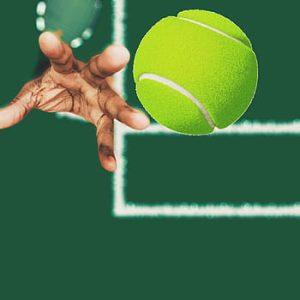We may earn money or products from the companies mentioned in this post.
Introduction

Tennis is a sport that has captivated both players and spectators for centuries Originating in 12th century France, this elegant game has evolved into a global phenomenon, with millions of people around the world picking up a racket and stepping onto the court
At its core, tennis requires skill, agility, and mental strength The ability to accurately hit the ball over the net while strategizing your next move is what separates novices from skilled players And like any sport, practice is essential in honing those skills
A Brief Overview of Tennis as a Sport
Tennis has come a long way since its early beginnings What started as a game played by French monks using their hands gradually transformed into an organized sport with specific rules and equipment In the 19th century, major advancements were made in racket technology, making it easier to control the ball and increase power
Today, tennis is played on various surfaces such as grass, clay, and hard courts It has become one of the most popular sports worldwide, with tournaments like Wimbledon and the US Open attracting millions of viewers each year
The Importance of Practice and Consistency
In tennis, practice truly makes perfect Whether you’re a beginner or an experienced player looking to improve your skills, consistent practice is key Repetition helps develop muscle memory and improves hand-eye coordination
By dedicating time to practice regularly, players can refine their technique and build confidence on the court Consistency also helps with stamina and endurance – important factors during long matches where physical fitness plays a crucial role
The Challenge of Practicing Alone
While practicing with a partner or coach can provide valuable feedback and simulate real match scenarios, there are times when solo practice is necessary or preferred However, practicing alone presents its own set of challenges
One common issue faced by solo players is the lack of variety in shots Without a partner to hit different types of shots, it can be challenging to improve defensive skills and adaptability on the court Additionally, practicing alone can lead to a sense of isolation, as there’s no one to provide motivation or engage in friendly competition
The Benefits of Solo Practice
Despite the challenges, solo practice offers unique benefits that can accelerate skill development When practicing alone, players have the freedom to focus on specific areas they want to improve without being limited by their partner’s needs
Solo practice also allows players to work on their mental game Without distractions or external pressure, individuals can concentrate on developing mental resilience and maintaining focus during matches
Furthermore, solo practice encourages self-motivation and discipline It builds inner strength and determination as players rely solely on themselves for progress and improvement
Choosing the Right Equipment for Solo Practice

When it comes to solo practice in tennis, having the right equipment is essential Not only does it help in improving your skills, but it also ensures a comfortable and enjoyable experience on the court Let’s take a closer look at the must-have gear for playing tennis alone:
Tennis Racket: Selecting the Appropriate Type and Size
Your tennis racket is like an extension of your arm, so choosing the right one is crucial Consider factors such as weight, grip size, head size, and string tension when selecting a racket It’s important to find a racket that suits your playing style and skill level to maximize your performance during solo practice
Tennis Balls: Quality, Quantity, and Type (Pressureless or Pressurized)
The type of tennis balls you use can greatly impact your practice sessions Opt for high-quality balls that offer good durability and consistent bounce Additionally, consider whether you prefer pressureless or pressurized balls based on your personal preference and playing surface Having an ample quantity of tennis balls ensures uninterrupted practice without constantly retrieving them
Comfortable Attire and Footwear for Optimal Performance
Don’t overlook the importance of comfortable attire and footwear when practicing solo Choose breathable clothing that allows freedom of movement while keeping you cool on the court Invest in proper tennis shoes with adequate support and cushioning to prevent injuries during intense sessions
Additional Tools to Enhance Your Practice Experience

In addition to the essential gear mentioned above, there are additional tools that can elevate your solo practice sessions:
Ball Machines: Types, Features, and Benefits
A ball machine can be a game-changer for solo practice, providing a consistent feed of balls and simulating real-game scenarios There are various types available, including programmable machines that offer customizable drills, remote-controlled machines that allow you to adjust settings from a distance, and budget-friendly options for those on a tight budget Incorporating a ball machine into your practice routine can significantly enhance your skills
Rebound Nets and Walls: Helping You Return Shots Without an Opponent
When practicing alone, it’s essential to work on returning shots effectively Rebound nets and walls come in handy in such situations as they allow you to practice your strokes without the need for a partner Portable rebound nets are easy to set up and can be used anywhere, while wall-based solutions offer a solid surface for precise shot placement
By equipping yourself with the right gear and additional tools, you can make the most out of your solo tennis practice sessions Remember, consistency is key when it comes to improving your skills on the court!
Solo Tennis Drills to Improve Your Skills

Are you looking to take your tennis game to the next level? Solo drills are a fantastic way to enhance your skills and build a solid foundation for success on the court Whether you want to improve your groundstrokes, refine your net play strategies, or work on your serve and return, there are drills tailored for every aspect of the game Let’s dive into some solo tennis drills that will help you develop various areas of your game
Groundstroke Drills for Forehand and Backhand Development
A strong groundstroke is essential in dominating rallies from the baseline Here are three solo drills that will help you improve both your forehand and backhand:
-
Crosscourt Drill:
Practice hitting consistent crosscourt shots using both forehand and backhand Focus on generating power and maintaining control -
Down-the-Line Drill:
Hit down-the-line shots with precision This drill helps develop accuracy and placement on both sides of the court -
Inside-Out Forehand/Backhand Drill:
Work on hitting inside-out shots, which involve starting from one side of the court and finishing on the opposite side This drill improves footwork, timing, and shot selection
Volley Drills to Refine Net Play Strategies
To become a proficient net player, it’s crucial to practice volleys consistently These solo drills will enhance your net play skills:
-
Forehand Volley Drill:
Stand near the net and hit forehand volleys repetitively Focus on proper technique, quick reflexes, and effective positioning at the net -
Backhand Volley Drill:
Similar to the forehand volley drill, this focuses on improving your backhand volley technique and consistency -
Half-Volley Pickups at the Service Line:
Stand at the service line and work on half-volleys by picking up low balls before they bounce This drill enhances your ability to handle challenging shots near the net
Serve and Return Drills to Build Accuracy and Power
A strong serve and return game can give you a significant advantage in matches Here are some solo drills to help you improve these crucial aspects of your game:
-
Targeted Serve Practice with Cones or Markers:
Set up cones or markers on the service box and aim for specific targets while serving This drill improves accuracy, consistency, and placement -
Second Serve Consistency Challenge:
Focus on hitting consistent second serves under pressure Practice varying spin, placement, and speed to keep opponents off balance -
Returning Serves from a Ball Machine:
Use a ball machine to simulate different types of serves Work on your footwork, timing, and shot selection while returning serves from various angles
Incorporating these solo drills into your regular practice routine will undoubtedly elevate your tennis skills Consistency is key, so make sure to dedicate time each week to work on these drills Remember, practice makes perfect!
Conclusion – Maintaining motivation during solo practices

When it comes to solo tennis practices, keeping your motivation high can sometimes be a challenge However, with the right approach and mindset, you can make the most out of your practice sessions and continue to improve your skills Here are some key strategies to help you stay motivated:
Setting achievable goals within reasonable timelines
To maintain motivation during solo practices, it is important to set realistic goals that you can work towards Identify specific aspects of your game that you want to improve upon and break them down into smaller, achievable milestones This will not only give you a sense of direction but also provide a sense of accomplishment as you progress
Incorporating variety in drills and exercises
Solo practice doesn’t have to be monotonous To keep things interesting and engaging, try incorporating a variety of drills and exercises into your routine Watch coaching videos or online tutorials to learn new techniques and adopt them into your practice sessions Experiment with different shot types, spin, and pace to challenge yourself and enhance your overall game
Participating in social events or joining local clubs
While solo practice is essential for individual improvement, it’s equally important to connect with fellow players for motivation and camaraderie Consider participating in social events or joining local tennis clubs where you can interact with other like-minded individuals who share the same passion for the sport Engaging in friendly matches not only provides an opportunity to test your skills against others but also helps create a supportive community
By setting achievable goals, incorporating variety in drills, and connecting with fellow players through social events or local clubs, you can maintain a high level of motivation during solo practices Remember that consistency is key; even on days when motivation might be lacking, pushing through and sticking to your practice routine will ultimately lead to progress and improvement in your game
Useful Links

How To Practice Tennis By Yourself – 5 Different Ways
How Do You Teach Yourself To Play Tennis – 2023 Guide
Best Tennis Training Equipment
Practice Tennis Alone (How To)
Guide to Tennis Drills: 6 Types of Practice Exercises – 2023
How to Play Tennis (with Pictures)
10 Fun Tennis Drills You Can Practice Without A Court
Do You Need Another Person to Learn Tennis?
How Can I Learn Tennis | Beginners
How to Practice Tennis Indoors or at Home Without a …
Is it possible to learn tennis yourself without the help of a …
Playing Tennis Against a Wall: The Perfect Practice Partner
Need help: Solo practice drills, exercises, etc. : r/tennis
9 Best Tennis Drills You Can Do Alone (On & Off The Court)
Bouncing Off the Walls: An ode to the backboard (and 5 …
How to Play Tennis Alone? [Least to Most Expensive]
10 Ways To Improve Your Tennis Alone
How To Play Tennis In A More Relaxed Way






